| Country of origin | USSR |
|---|---|
| First flight | 1965-04-19 [1] |
| Designer | OKB-154 [1] |
| Manufacturer | PO Motorostroitel or Perm [2] |
| Application | ICBM propulsion |
| Associated LV | UR-100 [1] |
| Successor | RD-0235 |
| Status | Retired |
| Liquid-fuel engine | |
| Propellant | N2O4 [3] / UDMH [3] |
| Cycle | Oxidizer Rich Staged combustion [1] |
| Configuration | |
| Chamber | 1 [3] |
| Performance | |
| Thrust | 219 kilonewtons (49,000 lbf) [3] |
| Chamber pressure | 17.4 megapascals (2,520 psi) [3] |
| Specific impulse | 313 s (3.07 km/s) [3] |
| Used in | |
| UR-100 Core Stage [4] | |
| Country of origin | USSR |
|---|---|
| First flight | 1973-04-09 [5] |
| Designer | OKB-154 [5] |
| Manufacturer | Krasny Oktyabr factory [2] |
| Application | ICBM propulsion |
| Associated LV | UR-100N, Rokot and Strela [5] |
| Status | Out of Production |
| Liquid-fuel engine | |
| Propellant | N2O4 [6] / UDMH [6] |
| Cycle | Oxidizer Rich Staged combustion [5] |
| Configuration | |
| Chamber | 1 [6] |
| Performance | |
| Thrust | 240 kilonewtons (54,000 lbf) [6] |
| Chamber pressure | 17.5 megapascals (2,540 psi) [6] |
| Specific impulse | 320 s (3.1 km/s) [6] |
| Used in | |
| UR-100N Second Stage [6] | |
The RD-0216 (Russian : Ракетный Двигатель-0216, romanized: Raketnyy Dvigatel-0216, lit. 'Rocket Engine 0216') and RD-0217 are liquid rocket engines, burning N2O4 and UDMH in the oxidizer rich staged combustion cycle. [1] [3] The only difference between the RD-0216 and the RD-0217 is that the latter doesn't have a heat exchanger to heat the pressuring gasses for the tanks. [3] Three RD-0216 and one RD-0217 were used on the first stage of the UR-100 ICBM. [7] The engines were manufactured until 1974 and stayed in operational use until 1991. More than 1100 engines were produced. [3]
For the UR-100N project, while first stage propulsion was based on the more powerful RD-0233 engine. The second stage used a variation of the RD-0217 called the RD-0235 (GRAU Index 15D113). [8] It used a vacuum optimized nozzle extension, and thus had an extra 10 seconds of isp and 21 kilonewtons (4,700 lbf) [6] of more thrust. It has a fixed nozzle and relies on the RD-0236 vernier engine for thrust vectoring. While the engine has been out of production for a while, the UR-100NU and the Rokot and Strela use it as of 2015. [6]

The UR-100 was an intercontinental ballistic missile (ICBM) developed and deployed by the Soviet Union from 1966 to 1996. UR (УР) in its designation stood for Universal Rocket. It was known during the Cold War by the NATO reporting name SS-11 Sego and internally by the GRAU index 8K84. The Strela and Rokot carrier rockets were based on it.
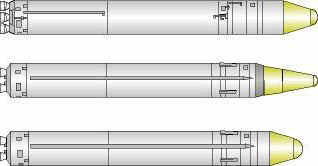
The UR-100N, also known as RS-18A, is an intercontinental ballistic missile in service with Soviet and Russian Strategic Missile Troops. The missile was given the NATO reporting name SS-19 Stiletto and carries the industry designation 15A30.

Rokot, also transliterated Rockot, was a Soviet Union space launch vehicle that was capable of launching a payload of 1,950 kilograms (4,300 lb) into a 200-kilometre (120 mi) Earth orbit with 63° inclination. It was based on the UR-100N intercontinental ballistic missile (ICBM), supplied and operated by Khrunichev State Research and Production Space Center. The first launches started in the 1990s from Baikonur Cosmodrome out of a silo. Later commercial launches commenced from Plesetsk Cosmodrome using a launch ramp specially rebuilt from one for the Kosmos-3M launch vehicle. The cost of the launcher itself was about US$15 million in 1999; The contract with European Space Agency (ESA) for launching Swarm in September 2013 was worth €27.1 million.
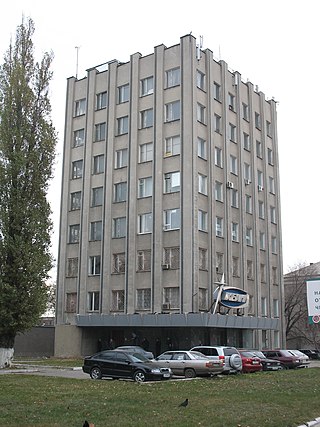
Chemical Automatics Design Bureau (CADB), also KB Khimavtomatika, is a Russian design bureau founded by the NKAP in 1941 and led by Semyon Kosberg until his death in 1965. Its origin dates back to a 1940 Moscow carburetor factory, evacuated to Berdsk in 1941, and then relocated to Voronezh city in 1945, where it now operates. Originally designated OKB-296 and tasked to develop fuel equipment for aviation engines, it was redesignated OKB-154 in 1946.
Strela is a Russian orbital carrier rocket, derived from the Soviet/Russian UR-100NU missile. It conducted its maiden test launch on 5 December 2003, carried its first functional payload on 27 June 2013, and a second one on 19 December 2014.
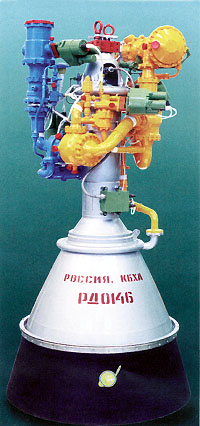
The RD-0146 (РД-0146) is a liquid-fuel cryogenic rocket engine developed by KBKhA Kosberg in Voronezh, Russia.

The RD-0110 is a rocket engine burning liquid oxygen and kerosene in a gas generator combustion cycle. It has four fixed nozzles and the output of the gas generator is directed to four secondary vernier nozzles to provide attitude control for the stage. It has an extensive flight history with its initial versions having flown more than 64 years ago.
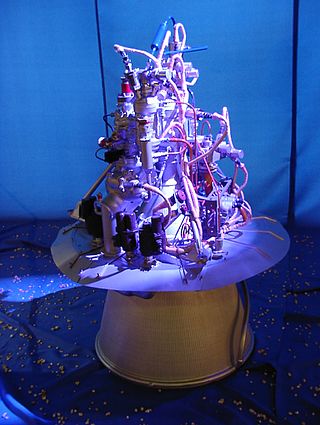
The RD-0109 is a rocket engine burning liquid oxygen and kerosene in a gas generator combustion cycle. It has single nozzle and is an evolution of the RD-0105. It was the engine used on the Vostok Block-E that launched Yuri Gagarin to orbit.
The RD-0214 (Russian: Ракетный Двигатель-0214 [РД-0214], romanized: Raketnyy Dvigatel-0214, lit. 'Rocket Engine 0214', GRAU index: 8D811) is a vernier thruster rocket engine burning unsymmetrical dimethylhydrazine (UDMH) fuel with dinitrogen tetroxide (N2O4) oxidizer in a gas-generator cycle. It has four nozzles that can each gimbal 45 degrees in plane to provide thrust vectoring control to the RD-0212 propulsion module of Proton rocket's third stage. It is a revised version of the RD-0207 (Russian: РД-0214, GRAU index: 8D67).

The RD-0210 (Russian: Ракетный Двигатель-0210, romanized: Raketnyy Dvigatel-0210, lit. 'Rocket Engine 0210', GRAU index: 8D411K) is also known as the RD-465. It and its twin, the RD-0211, are rocket engines using unsymmetrical dimethylhydrazine (UDMH) as fuel and dinitrogen tetroxide (N2O4) as oxidizer in an oxidizer rich staged combustion cycle. They have a single nozzle, possess thrust vectoring and are the latest evolution in the RD-0203/4 lineage. They are the engines used on the Proton second stage. The RD-0213 is a fixed nozzle variation that is used on the RD-0212 module of the Proton third stage.
The RD-0243 is a propulsion module composed of an RD-0244 main engine and a RD-0245 vernier thruster. Both are liquid-fuel rocket engines, burning a hypergolic mixture of unsymmetrical dimethylhydrazine (UDMH) fuel with dinitrogen tetroxide oxidizer. The RD-0244 main engine operates in the oxidizer rich staged combustion cycle, while the vernier RD-0245 uses the simpler gas generator cycle. Since volume is at a premium on submarine launches, this module is submerged on the propellant tank. Its development period was from 1977 to 1985, having had its first launch on December 27, 1981. Originally developed for the RSM-54, it was used later for the Shtil'.
The RD-0233 and RD-0234 are liquid-fueled rocket engines which burn a hypergolic mixture of unsymmetrical dimethylhydrazine (UDMH) fuel with dinitrogen tetroxide oxidizer in an oxidizer-rich staged combustion cycle. The only difference between the RD-0233 and the RD-0234 is that the latter has a heat exchanger to heat the pressuring gasses for the tanks. Three RD-0233 and one RD-0234 are used on the first stage of the UR-100UTTKh ICBM. While the engine is out of production, the ICBM as well as Rokot and Strela remain operational as of 2015.
The RD-0236 is a vernier thruster engine for liquid-fueled rockets. It burns a hypergolic mixture of unsymmetrical dimethylhydrazine (UDMH) fuel with dinitrogen tetroxide oxidizer in a gas generator cycle. It is used along the RD-0235 main engine on the UTTKh second stage, which was featured in the UR-100N ICBM as well as the Strela and Rokot launch vehicles derived from it. Its function is to supply thrust vector control by gimbaling each of its four nozzles in a plane. While the engine is out of production, the ICBM as well as Strela remain operational as of 2015. The Rokot launch vehicle conducted its final launch before retirement in December 2019.
The RD-0237 is a vernier thruster engine used on liquid-fueled rockets burning a hypergolic mixture of unsymmetrical dimethylhydrazine (UDMH) fuel with dinitrogen tetroxide oxidizer, pressure-fed to the engine. It is used on the UR-100UTTKh MIRV vehicle to supply thrust vector control by gimbaling of its nozzle. While the engine is out of production, the ICBM and Strela remain operational as of 2015.
The RD-263 is a liquid-fuel rocket engine, burning a hypergolic mixture of unsymmetrical dimethylhydrazine (UDMH) fuel with dinitrogen tetroxide oxidizer in the oxidizer rich staged combustion cycle. Four RD-263 engines form a propulsion module RD-264. For the R-36M KB Yuzhnoye only ordered the first stage propulsion to Energomash, instead of both stages, arguing that they were overworked with the RD-270 development. By April 1970 Yuzhnoye was getting the engine documentation. By the end of 1972 Energomash started to test fire the engines in its own test stand. And by September 1973 the engine was certified for flight. While the engine is out of production, the ICBM as well as the Dnepr remain operational as of 2015.

The RD-119 was a liquid rocket engine, burning liquid oxygen and UDMH in the gas-generator cycle. It has a huge expansion ratio on the nozzle and uses a unique propellant combination to achieve an extremely high isp of 352 s for a semi-cryogenic gas-generator engine. It also has a unique steering mechanism. The engine main nozzle is fixed, and the output of the gas generator is fed into four nozzles on the side of the engine. Instead of using gimbaled verniers to supply vector control, the combustion gases are distributed by an electrically driven system that can control the thrust among the nozzles.

The RD-214 (GRAU Index 8D59) was a liquid rocket engine, burning AK-27I (a mixture of 73% nitric acid and 27% N2O4 + iodine passivant and TM-185 (a kerosene and gasoline mix) in the gas generator cycle. As was the case with many V-2 influenced engines, the single turbine was driven by steam generated by catalytic decomposition of hydrogen peroxide. It also had four combustion chambers and vector control was achieved by refractory vanes protruding into the nozzle's exhaust.
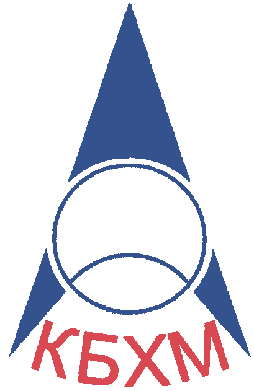
The A.M. Isayev Chemical Engineering Design Bureau, also known as KB KhimMash or just KBKhM, is a Russian rocket engine design and manufacturing company. It is located in the city of Korolyov. It started as the OKB-2 division of the NII-88 research institute, where A.Isaev directed the development of liquid rocket engines for ballistic missile submarines.
The RD-0255 is a propulsion module composed of an RD-0256 main engine and a RD-0257 Vernier thruster. Both are liquid-fuel rocket engines, burning a hypergolic mixture of unsymmetrical dimethylhydrazine (UDMH) fuel with dinitrogen tetroxide oxidizer. The RD-0256 main engine operates in the oxidizer rich staged combustion cycle, while the vernier RD-0257 uses the simpler gas generator cycle. It was used on the R-36MUTTKh (GRAU:15A18) and R-36M2 (GRAU:15A18M). Subsequently, it has been in the Dnepr second stage and as of 2016 it is still in active service.
The RD-0126 "Yastreb" was a liquid-fuel cryogenic rocket engine burning liquid hydrogen and liquid oxygen, developed by KBKhA Kosberg in Voronezh, Russia. The RD-0126 variant had a conventional de Laval nozzle, while the RD-0126E (РД-0126Э) was designed and constructed with an expansion-deflection nozzle. Both variants were designed to produce 39.2 kN (8,812.5 lbf) of thrust.